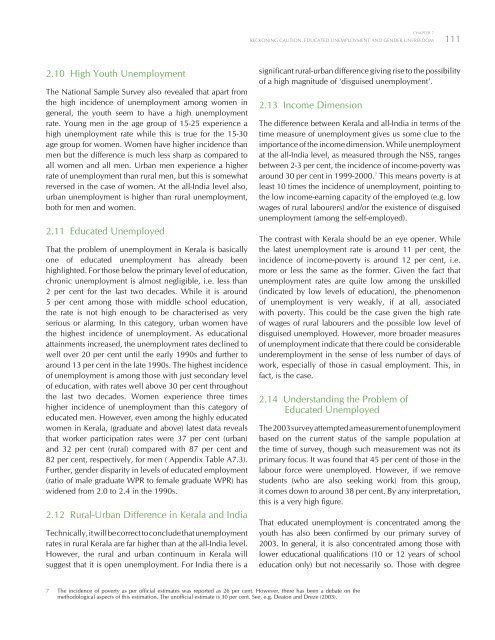Kerala 2005 - of Planning Commission
Kerala 2005 - of Planning Commission
Kerala 2005 - of Planning Commission
You also want an ePaper? Increase the reach of your titles
YUMPU automatically turns print PDFs into web optimized ePapers that Google loves.
CHAPTER 7<br />
RECKONING CAUTION: EDUCATED UNEMPLOYMENT AND GENDER UNFREEDOM<br />
111<br />
2.10 High Youth Unemployment<br />
The National Sample Survey also revealed that apart from<br />
the high incidence <strong>of</strong> unemployment among women in<br />
general, the youth seem to have a high unemployment<br />
rate. Young men in the age group <strong>of</strong> 15-25 experience a<br />
high unemployment rate while this is true for the 15-30<br />
age group for women. Women have higher incidence than<br />
men but the difference is much less sharp as compared to<br />
all women and all men. Urban men experience a higher<br />
rate <strong>of</strong> unemployment than rural men, but this is somewhat<br />
reversed in the case <strong>of</strong> women. At the all-India level also,<br />
urban unemployment is higher than rural unemployment,<br />
both for men and women.<br />
2.11 Educated Unemployed<br />
That the problem <strong>of</strong> unemployment in <strong>Kerala</strong> is basically<br />
one <strong>of</strong> educated unemployment has already been<br />
highlighted. For those below the primary level <strong>of</strong> education,<br />
chronic unemployment is almost negligible, i.e. less than<br />
2 per cent for the last two decades. While it is around<br />
5 per cent among those with middle school education,<br />
the rate is not high enough to be characterised as very<br />
serious or alarming. In this category, urban women have<br />
the highest incidence <strong>of</strong> unemployment. As educational<br />
attainments increased, the unemployment rates declined to<br />
well over 20 per cent until the early 1990s and further to<br />
around 13 per cent in the late 1990s. The highest incidence<br />
<strong>of</strong> unemployment is among those with just secondary level<br />
<strong>of</strong> education, with rates well above 30 per cent throughout<br />
the last two decades. Women experience three times<br />
higher incidence <strong>of</strong> unemployment than this category <strong>of</strong><br />
educated men. However, even among the highly educated<br />
women in <strong>Kerala</strong>, (graduate and above) latest data reveals<br />
that worker participation rates were 37 per cent (urban)<br />
and 32 per cent (rural) compared with 87 per cent and<br />
82 per cent, respectively, for men ( Appendix Table A7.3).<br />
Further, gender disparity in levels <strong>of</strong> educated employment<br />
(ratio <strong>of</strong> male graduate WPR to female graduate WPR) has<br />
widened from 2.0 to 2.4 in the 1990s.<br />
2.12 Rural-Urban Difference in <strong>Kerala</strong> and India<br />
Technically, it will be correct to conclude that unemployment<br />
rates in rural <strong>Kerala</strong> are far higher than at the all-India level.<br />
However, the rural and urban continuum in <strong>Kerala</strong> will<br />
suggest that it is open unemployment. For India there is a<br />
significant rural-urban difference giving rise to the possibility<br />
<strong>of</strong> a high magnitude <strong>of</strong> ‘disguised unemployment’.<br />
2.13 Income Dimension<br />
The difference between <strong>Kerala</strong> and all-India in terms <strong>of</strong> the<br />
time measure <strong>of</strong> unemployment gives us some clue to the<br />
importance <strong>of</strong> the income dimension. While unemployment<br />
at the all-India level, as measured through the NSS, ranges<br />
between 2-3 per cent, the incidence <strong>of</strong> income-poverty was<br />
around 30 per cent in 1999-2000. 7 This means poverty is at<br />
least 10 times the incidence <strong>of</strong> unemployment, pointing to<br />
the low income-earning capacity <strong>of</strong> the employed (e.g. low<br />
wages <strong>of</strong> rural labourers) and/or the existence <strong>of</strong> disguised<br />
unemployment (among the self-employed).<br />
The contrast with <strong>Kerala</strong> should be an eye opener. While<br />
the latest unemployment rate is around 11 per cent, the<br />
incidence <strong>of</strong> income-poverty is around 12 per cent, i.e.<br />
more or less the same as the former. Given the fact that<br />
unemployment rates are quite low among the unskilled<br />
(indicated by low levels <strong>of</strong> education), the phenomenon<br />
<strong>of</strong> unemployment is very weakly, if at all, associated<br />
with poverty. This could be the case given the high rate<br />
<strong>of</strong> wages <strong>of</strong> rural labourers and the possible low level <strong>of</strong><br />
disguised unemployed. However, more broader measures<br />
<strong>of</strong> unemployment indicate that there could be considerable<br />
underemployment in the sense <strong>of</strong> less number <strong>of</strong> days <strong>of</strong><br />
work, especially <strong>of</strong> those in casual employment. This, in<br />
fact, is the case.<br />
2.14 Understanding the Problem <strong>of</strong><br />
Educated Unemployed<br />
The 2003 survey attempted a measurement <strong>of</strong> unemployment<br />
based on the current status <strong>of</strong> the sample population at<br />
the time <strong>of</strong> survey, though such measurement was not its<br />
primary focus. It was found that 45 per cent <strong>of</strong> those in the<br />
labour force were unemployed. However, if we remove<br />
students (who are also seeking work) from this group,<br />
it comes down to around 38 per cent. By any interpretation,<br />
this is a very high figure.<br />
That educated unemployment is concentrated among the<br />
youth has also been confirmed by our primary survey <strong>of</strong><br />
2003. In general, it is also concentrated among those with<br />
lower educational qualifications (10 or 12 years <strong>of</strong> school<br />
education only) but not necessarily so. Those with degree<br />
7 The incidence <strong>of</strong> poverty as per <strong>of</strong>ficial estimates was reported as 26 per cent. However, there has been a debate on the<br />
methodological aspects <strong>of</strong> this estimation. The un<strong>of</strong>ficial estimate is 30 per cent. See, e.g. Deaton and Dreze (2003).

















